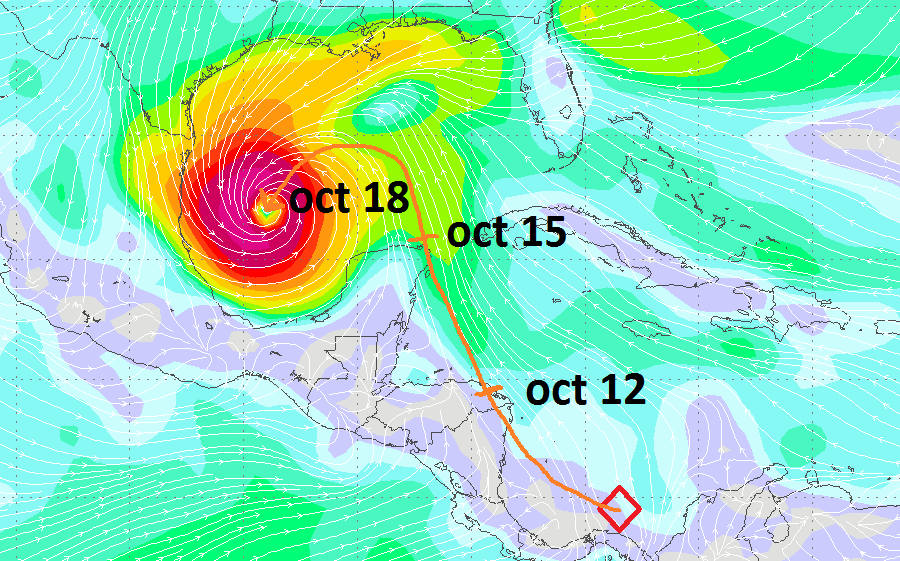Before you flood you friends with posts on social media about the next tropical depression, tropical storm or hurricane – stop and read the article attached to the picture. And pay close attention to the author. Chances are the person writing it isn’t a meteorologist. It may be a “weather enthusiast” or storm chaser that posts a picture and a forecast.
But it won’t be a meteorologist. As a heads up, this is a snapshot from the latest GFS (18z on 10/6/14):
If you see something similar to this picture floating around social media, please don’t share it, retweet it or start to worry.
I’ll prove to you why. And while this might seem to get a little confusing, please stay with me…
So close, yet so far away…
To give you an idea of how far out this is, I want to make an analogy. A simplified version of what the computers do to figure out if a storm is going to develop.
Here is an idea of an equation:
X + Y + Z + A + B + C = H
We will let H = Hurricane and the other letters are place holders for numbers. Each place holder is also for a day in the future. In the real world, for a hurricane to form, you need a big, long list of variables to add together to give you a hurricane. But in this case we are going to simplify things. Tremendously. We are going to widdle that list down to six things. And really we are going to say that it is just one variable, on each day.
So simple! We are just going to assign each day a number.
So we are looking six days into the future and trying to see if we can add together some numbers that equal a hurricane.
By the way, the letters that represent those numbers could be anything. One or 12 or 55,000. But, because it is weather, we do need to make them dependent on the previous letters, too.
X = ?
Y = X + ?
Z = X + Y + ?
A = X + Y + Z + ?
B = X + Y + Z + A + ?
C = X + Y + Z + A + B + ?
Let’s take a trip to SimpleVille
Remember that I mentioned to get a hurricane it takes a lot of different variables to come together? In this scenario we are living in SimpleVille. So to simplify things, let’s say that all we have to do is make H = 60 in that equation above.
Seems simple enough, right?
And to add to the simplicity the ? will always be 1. So, in this case, we have a good idea what X is.
X = 1.
I know what you are thinking: “Nick, if ? = 1 how are we going to get all the way to 60?!? There is no way we get a hurricane!”
Stay with me!
Back to the easy math… Now Y is still simple. Y = X + ? And since X = 1 and ? = 1, we get 2.
And if we continue this trend, Z = X + Y + ? then Z = 1 + 2 + 1 or Z = 4
If you’re getting confused, hang in there. We’re going to skip ahead and figure out all of the letters in the above equation.
X = 1
Y = 2
Z = 4
A = 8
B = 15
C = 30
So H = 1 + 2 + 4 + 8 + 15 + 30
So H = 60
Well, how about that! H = 60 and we need 60 to make a hurricane! In our SimpleVille hypothetical situation we got one!
Hooray!
The math gets slightly trickier
But hold on just a second. The real world, sadly, isn’t that easy. Because what happens if we change what the ? is and it makes X = 2?
X = 2
Y = 3
Z = 5
A = 11
B = 22
C = 44
So H = 87! That’s not 60! That means we don’t have a hurricane! And we were only off by one! On a single letter!
What if we picked numbers – for easy math, we’ll keep them under 20 – at random?
X = 14
Y = 9
Z = 2
A = 19
B = 11
C = 8
That means H = 63. Close, but again, no hurricane. Did you know that we could change those numbers around more than one hundred times and still not come up with 60 again?
He’s about to get on his soap box, isn’t he?
So what does all of this mean? Why did I confuse everyone?
Forecasting isn’t simple. This “simplified” example is likely upsetting meteorologists that read this because it grossly oversimplifies forecasting hurricanes.
But I think it drives the point home. We only looked six days into the future at one variable while computer weather models are looking at hundreds of variables on hourly scales trying to predict 16 days into the future. At that rate, just think at all of the places that errors can pop up because the computer was off on a number by one. Or two. Or 50.
So the next time someone tells you that a big storm is headed toward you and it is more than six days away, I hope that you stop and remember this example.
And you think, a lot can change in six days.


